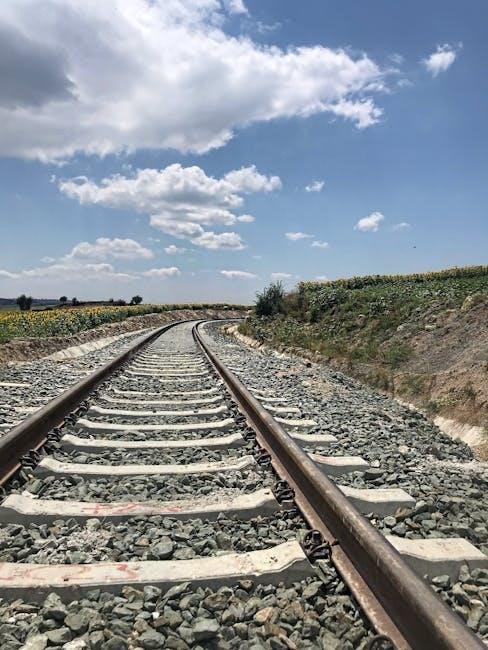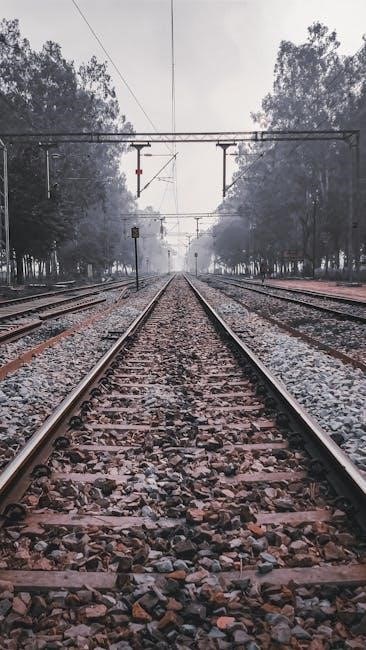
-
By:
- ida
- No comment
track rollers and guide rails
Track rollers and guide rails are essential components enabling smooth motion and stability in machinery. They are widely used in industrial, agricultural, and material handling systems. These systems ensure precise alignment and reduce friction, enhancing operational efficiency. Their versatility allows application in both linear and curved setups, catering to diverse mechanical needs. This section introduces their fundamental role in modern machinery, setting the stage for deeper exploration in subsequent chapters.
1.1 Definition and Purpose
Track rollers are cylindrical or spherical components designed to support and guide moving parts in machinery, reducing friction and wear. Guide rails are fixed pathways that ensure stable movement and alignment of these rollers. Together, they enable precise motion control, distribute loads evenly, and enhance the durability of mechanical systems. Their primary purpose is to facilitate smooth, efficient, and consistent operation across various industrial and mechanical applications.
1.2 Importance in Industrial and Mechanical Systems
Track rollers and guide rails are critical for maintaining precision, stability, and efficiency in industrial machinery. They support heavy loads, reduce friction, and prevent wear on moving parts, ensuring reliable operation. Their role in minimizing downtime and extending equipment lifespan makes them indispensable in manufacturing, construction, and material handling systems, where consistent performance is paramount for productivity and cost efficiency.

Types of Track Rollers
Track rollers are categorized into cylindrical and spherical types. Cylindrical rollers are ideal for heavy loads and linear motion, while spherical rollers handle misalignment and high loads efficiently.
2.1 Cylindrical Rollers
Cylindrical rollers are designed for heavy load applications and provide smooth linear motion. Their elongated shape minimizes surface contact, reducing friction and wear. They are commonly used in industrial machinery and conveyors due to their durability and ability to handle high stress. Proper lubrication is essential to extend their lifespan and maintain optimal performance in demanding environments.
2.2 Spherical Rollers
Spherical rollers are ideal for systems requiring misalignment accommodation and self-aligning capabilities. Their rounded design allows smooth operation on curved or angled tracks, reducing stress concentrations. Constructed from durable materials like steel or ceramic, they excel in high-load applications. Regular lubrication and inspections are crucial for maintaining their performance and extending service life in demanding environments.
Guide Rails and Their Applications
Guide rails provide stable pathways for moving components, ensuring smooth operation in machinery. Made from durable materials like steel or aluminum, they are used in conveyor systems, automation, and heavy-duty applications.
3.1 Linear Guide Rails
Linear guide rails are designed for smooth, precise movement in straight-line applications. Made from durable materials like steel or aluminum, they are widely used in conveyor systems, industrial automation, and heavy machinery. These rails ensure minimal friction and high load capacity, making them ideal for applications requiring consistent motion control. Their simplicity and reliability make them a cornerstone in material handling and manufacturing processes.
3.2 Curved Guide Rails
Curved guide rails are designed for applications requiring movement along non-linear paths. They are commonly used in conveyor systems, agricultural machinery, and construction equipment where precise alignment around corners or bends is necessary. These rails ensure smooth transitions and consistent load distribution, making them ideal for complex material handling and industrial automation. Their durability and adaptability make them essential for systems needing flexible motion control.
Key Components of Track Roller Systems
Track roller systems rely on pins, bushings, and frames to ensure smooth operation. These components provide structural support, enable movement, and maintain alignment, ensuring stability and efficiency.
4.1 Pins and Bushings
Pins and bushings are critical components in track roller systems, ensuring smooth articulation and load distribution. They connect rollers to frames, absorbing stress and wear. Regular inspection is essential to prevent overheating and damage. Proper lubrication extends their lifespan, maintaining system efficiency and reliability.
4.2 Frames and Mounting Options
Frames and mounting options are vital for stability and load support in track roller systems. They provide structural integrity and allow for customization to suit specific applications. Various mounting configurations, such as vertical or horizontal setups, ensure versatility. Proper alignment and secure fastening are crucial to prevent wear and ensure smooth operation. Durable materials and designs help withstand heavy loads and environmental factors.

Maintenance and Inspection Tips
Regular lubrication and thorough cleaning are crucial for optimal performance. Inspect pins, bushings, and frames for wear or heat buildup to prevent premature failure and ensure safety;
5.1 Lubrication and Cleaning
Lubrication is critical to reduce friction and wear on track rollers and guide rails. Use high-quality, waterproof grease for outdoor applications and high-temperature grease for extreme conditions. Regularly clean dirt and debris to prevent damage. Avoid harsh chemicals that might degrade materials. After cleaning, ensure all components are dry before reapplying lubricant. Inspect pins and bushings for excessive heat or wear during maintenance checks to ensure optimal performance and longevity of the system. Schedule lubrication every 500 operational hours for best results.
5.2 Crack Detection and Replacement
Regularly inspect track roller frames and guide rails for cracks using visual checks or non-destructive testing methods. Replace damaged components immediately to prevent system failure. Use specialized tools to remove worn or cracked parts and install new ones securely. Ensure all replacements meet original specifications for optimal performance. Keep spare parts on hand to minimize downtime during maintenance or repairs. Always follow manufacturer guidelines for replacement procedures to maintain system integrity and safety standards. Prompt action prevents costly repairs and enhances operational reliability.

Safety Considerations
Ensure proper installation and regular inspection of track rollers and guide rails. Always adhere to load capacity limits and install emergency stop mechanisms for quick system shutdown. This helps prevent accidents and ensures safe operation. Regular maintenance and timely repairs are crucial to avoid potential hazards. Follow safety standards and guidelines for optimal system performance.
6.1 Load Capacity and Weight Limits
Load capacity and weight limits are critical for safe operation. Always ensure track rollers and guide rails are used within their specified load ratings. Exceeding these limits can lead to premature wear, structural damage, or system failure. Proper installation and regular inspections are essential to verify that the system operates within safe parameters. Consulting manufacturer guidelines ensures optimal performance and prevents potential hazards. Adhering to these limits enhances safety and extends equipment lifespan.
6.2 Emergency Stop Mechanisms
Emergency stop mechanisms are vital safety features in track roller and guide rail systems. They enable immediate halting of machinery to prevent accidents. These mechanisms often include manual or automated triggers, ensuring quick response in critical situations. Proper installation and regular testing are essential to guarantee reliability. Compliance with safety standards further enhances system dependability, safeguarding both equipment and personnel during operations. Emergency stops minimize risks and downtime effectively.
Guide Rails in Material Handling Systems
Guide rails play a crucial role in material handling systems, enabling smooth movement of goods via conveyors and pulleys. They enhance operational efficiency and reduce downtime significantly.
7.1 Conveyor Systems and Automation
In conveyor systems, guide rails and track rollers ensure smooth material transport, minimizing friction and enhancing automation efficiency. These components provide stable paths for rollers, enabling seamless load distribution and alignment. By maintaining precise movement, they reduce wear and downtime, optimizing production workflows in manufacturing and logistics. Their integration is vital for modern, high-speed automation systems, ensuring reliable and consistent material handling operations across various industries.
7.2 Drawer Slides and Pulley Systems
In drawer slides and pulley systems, track rollers and guide rails facilitate smooth, controlled movement. They ensure drawers open and close effortlessly, while pulleys manage load distribution. Vertical mounting and counterweight options enhance functionality, allowing for customizable solutions. These components are crucial for efficient material handling, reducing friction and wear. Their durability and precision make them integral to both industrial and domestic applications, ensuring reliable operation over time.
Track Rollers in Heavy Machinery
Track rollers are critical in heavy machinery, ensuring smooth operation and load support. They are widely used in construction and agricultural equipment, enhancing stability and durability.
8.1 Construction Equipment Applications
Track rollers are indispensable in construction machinery, providing stability and support for heavy loads. They are commonly used in excavators, bulldozers, and cranes to ensure smooth operation. Their robust design withstands harsh environments, facilitating efficient movement and load distribution. Proper maintenance, including lubrication and crack detection, is crucial for longevity. These rollers are vital for construction projects, ensuring equipment reliability and operational safety in demanding conditions.
8.2 Agricultural Machinery Use Cases
Track rollers are integral to agricultural machinery, such as tractors and harvesters, ensuring smooth operation in challenging terrains. Their durable design handles heavy loads and repetitive motions, minimizing wear and tear. Regular lubrication and inspection are crucial for maintaining functionality. These components enhance efficiency in farming operations, enabling reliable performance and reducing downtime during critical tasks like planting and harvesting.

Customization and Specialized Solutions
Customization options for track rollers and guide rails include vertical mounting and adjustable designs, offering tailored solutions for specific applications and enhancing functionality to meet unique demands.
9.1 Vertical Mounting Options
Vertical mounting options for track rollers and guide rails provide flexibility in installation, particularly in systems requiring overhead or wall-mounted solutions. These setups often incorporate clamps, counterweights, or pulleys to ensure stability and ease of use. Vertical configurations are ideal for applications where space is limited or when machinery needs to be elevated for better accessibility. This customization enhances functionality while maintaining durability and performance across various industries, including construction and agriculture.
9.2 Hinged and Adjustable Designs
Hinged and adjustable designs offer enhanced flexibility in track roller systems, allowing components to swing or pivot for easier maintenance and installation. These designs enable precise alignment and tension adjustments, ensuring optimal performance. Adjustable features are particularly useful in applications requiring frequent modifications or in systems with varying loads. Hinged elements also facilitate access to internal mechanisms without dismantling the entire setup, streamlining maintenance processes across industries.

Future Trends and Innovations
Future trends in track rollers and guide rails include advanced materials, smart technologies, and sustainable designs. These innovations aim to enhance performance, efficiency, and adaptability across various industries.
10.1 Advanced Materials and Coatings
Next-generation track rollers and guide rails are being developed with advanced materials like stainless steel, ceramics, and polymers, offering improved durability and corrosion resistance. Cutting-edge coatings, such as titanium nitride and diamond-like carbon, enhance wear resistance and reduce friction. These innovations are expected to boost performance in harsh environments and extend lifespan, making them ideal for heavy machinery and industrial applications where reliability is critical. Future materials may also focus on sustainability and energy efficiency.
10.2 Smart Guide Rail Systems
Smart guide rail systems integrate sensors and automation to optimize performance. These systems monitor wear, alignment, and load distribution in real-time, enabling predictive maintenance. Advanced algorithms adjust guide rail positions dynamically, improving precision and reducing downtime. IoT connectivity allows remote monitoring, enhancing operational efficiency. Such systems are increasingly used in manufacturing and logistics, offering a future where guide rails adapt intelligently to varying conditions, minimizing human intervention and maximizing productivity.

Environmental and Durability Factors
Track rollers and guide rails must withstand harsh environments, including moisture and extreme temperatures. Durable materials and coatings ensure resistance to corrosion and wear. Proper sealing and regular maintenance extend lifespan, while vibration-dampening technologies enhance stability and reduce noise in demanding applications, ensuring reliable performance over time.
11.1 Weather Resistance and Corrosion Protection
Track rollers and guide rails are often exposed to harsh outdoor conditions, requiring robust weather resistance and corrosion protection. Stainless steel and coated materials are commonly used to withstand moisture and humidity. Advanced surface treatments and sealing technologies prevent rust and ensure durability in wet or corrosive environments. Regular inspection and maintenance further enhance longevity, ensuring reliable performance in challenging weather conditions and extending the lifespan of these critical components.
11.2 Vibration Dampening Technologies
Vibration dampening technologies are crucial for minimizing wear and tear in track roller systems. Rubber coatings and hydraulic systems are commonly used to absorb shocks and reduce noise. These innovations prevent structural damage and ensure smooth operation, even in high-stress environments. Advanced materials and shock-absorbing pads further enhance stability, making them indispensable in heavy machinery and industrial applications where vibrations are prevalent;
Track rollers and guide rails are vital for efficient machinery operation, offering durability and versatility. Future innovations promise enhanced performance, ensuring continued relevance in evolving industries.
12.1 Summary of Key Points
Track rollers and guide rails are critical for ensuring smooth motion and stability in machinery. Their applications span industrial, agricultural, and material handling systems. Proper maintenance, including lubrication and crack detection, is essential for longevity. Customization options like vertical mounting and adjustable designs cater to specific needs. Future innovations, such as advanced materials and smart systems, promise enhanced efficiency and reliability, solidifying their importance in modern machinery.
12.2 Future Outlook for Track Rollers and Guide Rails
The future of track rollers and guide rails lies in advanced materials and smart technologies. Innovations like self-lubricating coatings and IoT-integrated systems will enhance efficiency and reduce maintenance. As industries prioritize sustainability, eco-friendly designs and energy-efficient solutions will dominate. These advancements will ensure track rollers and guide rails remain vital in modern machinery, driving progress across manufacturing, agriculture, and material handling sectors.